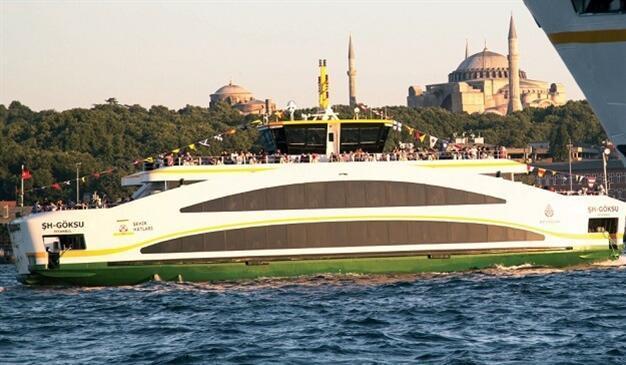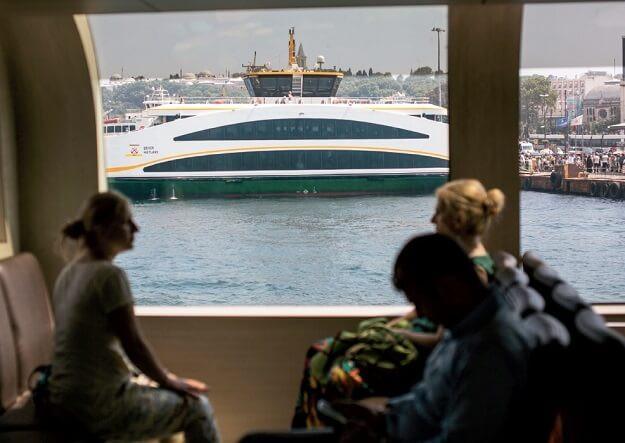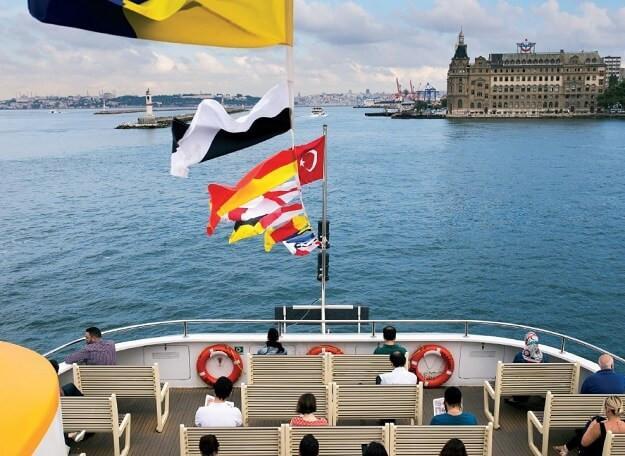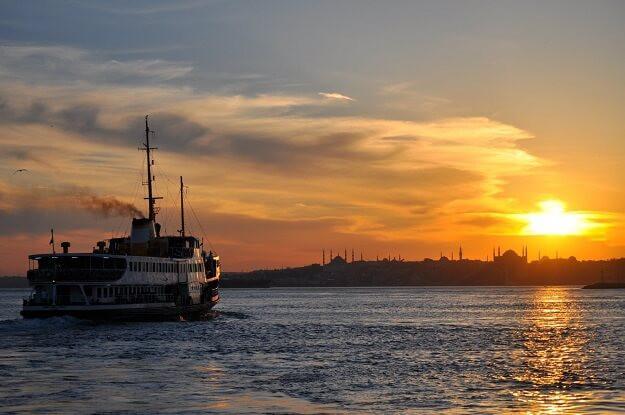New ferries pose threat to historic fabric and authenticity of Istanbul
Gökhan Tan - ATLAS

Three new ferries, named Göksu, Küçüksu and Durusu, silently went into use in the early days of the summer in Istanbul. It can be considered a silent inauguration, because the new ferries were put into service without consulting the public, although Istanbul Mayor Kadir Topbaş had made a promise on June 20, 2013, after the Gezi Park protests, that they “would ask the public first before even relocating a bus stop.”
The new sea vessels were subjected to heavy criticism from descriptions as “a shanty house posed as a ferry” to questions such as “what did we do to deserve such hideousness?”
The reaction was towards the commissioning of the ferries without the public’s consent as much as it was towards their appearances because the people of Istanbul had demonstrated their sensitivity towards ferries in 2005 when the City Sea Lines Management was handed over from the General Directorate of Maritime Lines to the Istanbul Metropolitan Municipality (İBB).
Coinciding with the first period of Mayor Topbaş’s administration, this process identified with the slogan “I am not giving up my ferry” resulted in the designing of the new ferry model being determined through a public vote. In 2006, citizens of Istanbul voted on eight different ferry designs over the course of two months. This was how the 1700-passenger capacity Fatih, Beyoğlu, Kadıköy and Sarıyer ferry models were designated.
The news in the press mainly brought up the lack of public consultation in the process, despite the 2006 experience and the statement that they “would ask the public first before even relocating a bus stop.”
In reality Mayor Topbaş shared the first images of the new “ferries” on his Twitter account on Feb. 5, 2014, and stated that the people would be able to decide on their color. So “the people’s say” was reduced from picking the model to the color. However, even this much public consultation was not made while putting Istanbul’s newest fleet of sea vessels into service.
They are not even ferries (“vapur” in Turkish), technically. Neither Topbaş nor its designers designate this vessel as a ferry. According to the İBB, the vessel is called a “double-ended-type passenger ship.” The engineers that designed it prefer the term “passenger boat.”
After the reactions the ferries got, City Lines made a single statement: “First and foremost, it should be known that these ferries will not replace the ferries that have been identified with Istanbul, becoming the symbol of the city. Since their commission, they have been carefully referred to as the new ships rather than ferries in order to specify them not being the replacements of the ferries or not an alternative to them.” (daily Habertürk, June 5).
Yet these ships, not labelled as ferries and said not to be an alternative to ferries are named after the two historic Göksu (1851) and Küçüksu (1910) ferries of the Şirket-i Hayriye (what the City Line was known as until 1945). Once again, ironically, they are placed in the “ferries” page of City Line’s website. Unlike all the other – actual - ferries on the site, they are not given a description.
Chamber of Naval Architects & Marine Engineers (GMO) President Sinem Serhan Dedetaş interprets the refusal of not labelling these new vessels as ferries as the following: “Though they are mentioned as ‘ships’ by City Line, these are vessels that navigate in the Bosphorus, working on the ferry route. Therefore, there is no reason not to label these vessels as the ‘new ferries.’ And if you are to operate them as ferries, the reaction you get is just.
'Another design was not possible'
The new vessels were designed by ARTI Engineering in Tuzla and produced in the Özata Shipyard. The designers attended a chat in Karaköy on June 19 on the invitation of the GMO and answered their colleagues’ questions. City Lines was also invited to the gathering, but did not participate.
The design engineers argued there was no other way to design the vessels due to the restrictions and conditions on the contract City Lines drew up, such as wanting double-heads and double-ramps. They stated, for this reason, the ship they designed was not a passenger ferry but a boat with easier on board and off board access.
Serdar Yaraş from the design crew also revealed the vessels were ordered for short routes such as Beşiktaş-Üsküdar, however after the designing process it was revealed they were to be put into use on the Bosphorus line as well.
GMO President Dedetaş stated the ship lacked nothing in terms of engineering and technique and the responsibility of its design belonged to “the customer” and for that reason their colleagues should not be accused for it: “After City Lines express their desire to have this specific design, the engineers do not have a right to say ‘I do not want this.’ If we are to discuss these ferries in terms of aesthetics, then I can say they do not fit Istanbul. Should ferries be renewed? Yes. But is this the way to go about it? No. This made everyone uneasy.”
On June 4, daily Hürriyet’s website did what the municipality did not and asked its readers, “Do you like the new City Lines ferries of Istanbul?” A total of 79 percent of the 13,034 people who answered replied “no.”
Professional tour guide, cultural researcher and author Faruk Pekin said, “The municipality often says they ‘will ask even about the bus stops’ but does not even ask about more important things. They do not ask the opinion of the public on the grounds that they are ‘not being constructive.’ Well, you do not ask at all? The urbanite wishes to be involved in the decision-making process of these kinds of things. How do you explain to someone who sees this hideousness in Istanbul for the first time? Are you to say, ‘they did it behind our backs?’ I cannot stomach the fact that those ferries go around the Bosphorus.”
Pekin does not think these new “ferries” should be objected to on nostalgic grounds but rather on the grounds that they do not suit Istanbul’s contemporary production capacity. “Contemporary design serves the tourism of culture. However there was an outcome that does not fit the creative force of the city. In fact, this power was abused. This is a blow to the city’s artistic power, creative force and the urban culture. Whoever calls themselves an architect, designer or maritime engineer in this city should object to it. This objection does not mean a direct ‘no’ to everything. The purple color of the municipality busses was more thoroughly discussed than this, even though painting is an easy action; you can always repaint. However, there is an irreversible situation in the case of the ferries,” he said.
'Can you picture this ferry in front of Haydarpaşa?'
Another expert with the view that designs must be evaluated with the texture it takes place in is maritime engineer Tansel Timur. “The new ferries may not stand out in a Nordic European country, in an industrial city. But can you picture this ferry in front of Haydarpaşa? The changing of the phone booth designs in London is not even an issue. There could have been a focus on taking the ferries from the past and into the future. You may or may not like the designs made in 2006. Nevertheless, such an effort was made at the time.”
Timur approached the technical issues that are not dwelled upon distantly. For example, in these new designs, that are claimed to be more economical, the double-head and thus the double-propellers may cause an increase in water resistance and not be as economical as they are assumed to be. Timur asked, “Due to the ferries being double-sided, there is a saving of time from the dock manoeuvrings. Well then, what is done with this saved time? How does it affect us?”
Advertising and marketing expert Levent Erden, who makes a TV program on Istanbul’s history, also prefers not to associate the reactions shown to the “ferries” with nostalgia. According to Erden, the ferries are indispensable decorations that complete Istanbul’s identity and reinforce the feel of belonging to the city.
“There are some essentials of every city that absolutely have to be there, that make the city what it is. Like London’s phone booths, fire hydrants and road signs. There is already a huge issue of identity and belonging in this city whose population increased by thirty times over thirty years, where everyone brings in their own culture, which grows with migration rather than an organic expansion, where everyone asks one another where they are ‘originally from.’ Most of the people in Istanbul do not consider themselves from here. But the ferries belong here.”
According to Erden, there are many elements in a city like Istanbul whose disappearances are inevitable. However, special attention must be paid towards an element like the ferry which provided the “memory circulation” of the city. “For example, trams have vanished and no one remembers them. The Beyazıt Tower giving out the weather report may be symbolic for the town but perhaps will end sometime soon. The décor of the ferry must be maintained while there are many things that we are going to lose inevitably. The new ferries are more functional, capable. Could they have been made to look like the old ones? I suppose there was a bit of rushing involved. Some care could have been given. They blend in at the moment because there are so few of them but if there were to be more, what the city has lost would be revealed.”
In the preface of the now classic “Istanbul Gezi Rehberi” (Istanbul Travel Guide), Murat Belge explains the impact of rapid change on urban people as such:
“Such rapid growth creates a powerful change; difficult to digest (…) I think that such an intense temporality must be undermining the trust of the people in anything permanent. For example, you pass by somewhere all the time, therefore do not recognize it. The wall of St. Joseph on the way down to Şifa, for example, is there and has always been there. If you see the wall not there one day, it comes off as an odd feeling. An alarming hollowness that feels like you left the house with just your socks on, forgetting your shoes at home, not as if the wall was there, then disappeared.”
Translation: Alkım Kutlu
www.atlasdergisi.com
 Three new ferries, named Göksu, Küçüksu and Durusu, silently went into use in the early days of the summer in Istanbul. It can be considered a silent inauguration, because the new ferries were put into service without consulting the public, although Istanbul Mayor Kadir Topbaş had made a promise on June 20, 2013, after the Gezi Park protests, that they “would ask the public first before even relocating a bus stop.”
Three new ferries, named Göksu, Küçüksu and Durusu, silently went into use in the early days of the summer in Istanbul. It can be considered a silent inauguration, because the new ferries were put into service without consulting the public, although Istanbul Mayor Kadir Topbaş had made a promise on June 20, 2013, after the Gezi Park protests, that they “would ask the public first before even relocating a bus stop.”

